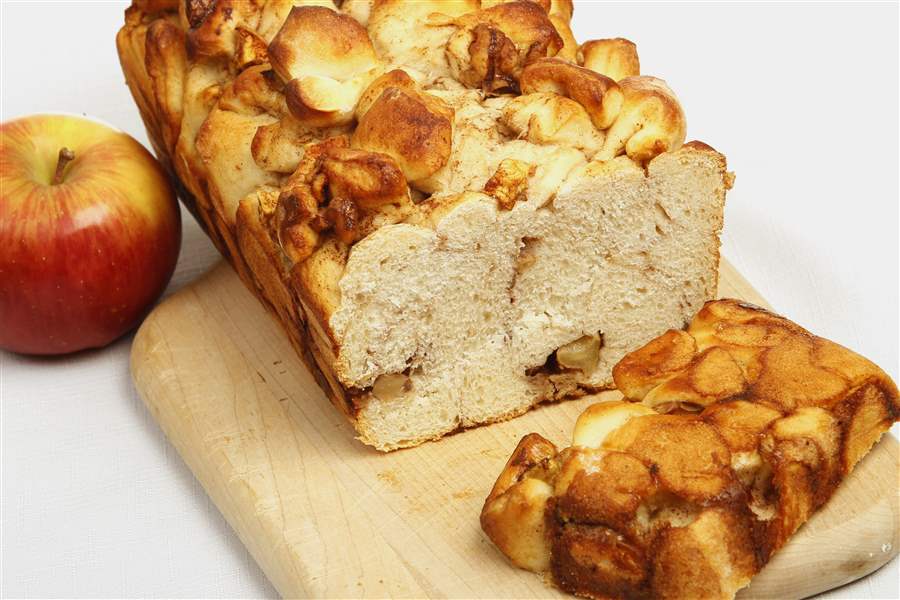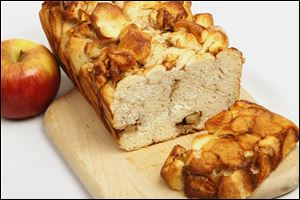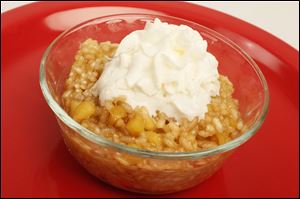
How ’bout them apples?
Since fall fruit is at a premium, it’s time to bake
10/2/2012
Chopped apple bread.
The Blade/Andy Morrison
Buy This Image
Editor's note: The print version of this story spelled Steve Elzinga's name incorrectly.

Chopped apple bread.
It was a bad year for a lot of crops. The drought knocked out much of the corn and clobbered the berries.
Local apples fared better against the lack of water, but they were already stunned by the first swing in Nature’s one-two punch: An unusually warm winter led to early blooms, which then got badly bloodied by late-season winter nastiness.
“We had 10 frosts and two hailstorms. It was a mess,” said Marlene MacQueen, co-owner of MacQueen Orchards in Holland. The untimely sequence of weather — first good, then bad — had a terrible effect on local farms, which are seeing only about 40 percent of their usual crop, she said.
Her husband, Bob MacQueen, the orchards’ co-owner and president, said, “we had the Fujis real light. The Jonagolds are about 20 percent of the [usual] crop. The Granny Smiths are probably 40 percent of the [usual] crop. But the Jonathans and Red and Golden Delicious came through pretty good.”
In other words, things are rough but they could be much worse. Michigan, he said, only grew about 2.9 million bushels of apples this year, compared to a crop of 26 million bushels last year. And the cherry crop was almost completely lost, he said.
Erie Orchards in Erie was lucky, said owner Steve Elzinga. Because it is located just 2½ miles from the warming air over Lake Erie, it missed the killing frosts.
“We have a full crop, we have a 100 percent crop, which is amazing. We even have more than anticipated,” he said. And while most years one or two varieties out of the dozen or so they grow do not come in well, “this year, every single variety is there.”
Meanwhile, Washington State has had such a banner year for apples that they are having trouble finding enough people to pick them, Mr. Elzinga said. But with local apples on the opposite side of the supply-demand spectrum, the prices here are going to be higher, he said.
The good news, though, is that although the number of apples is smaller, the apples themselves are larger than usual. That’s how Nature works: With fewer apples on the tree, the trees can devote all of their energy to growing the apples they have. And the drought helped concentrate the sugar levels, making them sweeter than usual too.

Apple risotto.
Well-established apple trees have roots that go so deep they were not affected by the drought, Mr. MacQueen said, but the younger trees required plenty of irrigation to keep them alive. As a result, MacQueen’s will have plenty of apples on hand for its 31st annual Apple Butter Festival and Craft Show on Saturday and Sunday from 10 a.m. to 6 p.m. Other area you-pick apple orchards are also open for business this season — which should last about three more weeks, Mr. MacQueen said.
The bottom line is that local apples are going to be fewer this year, and along with being better tasting they are also going to be more expensive. In other words, when you get them, make the most of them.
In other other words, it’s time to do some baking.
The all-American thing to do with apples, of course, is to put them into an all-American apple pie. And making it is as easy as, well, you know.
We decided to try a recipe provided by Americraft Cookware, a company that makes pie pans, figuring that they would know a good pie when they see one.
Their recipe recommends an equal mix of Granny Smith and Gala apples, so you get a blend of the tart and the sweet. These are sliced and tossed with white sugar, light brown sugar, and a little cinnamon, and sautéed until just tender in butter and a splash of lemon juice for added zest.
That’s easy enough, and if you want you can just bake it in a pre-made pie crust. But where is the fun in that? So I also made the crust from a recipe provided by Americraft Cookware, figuring that they would especially known a good pie crust when they see one. Besides, it included a trick I have long wanted to try.
Bakers know that to make flaky crusts you need to use ice water. The colder the water, the flakier the crust. But water, by definition, cannot drop below 32 degrees, unless you add a lot of salt. Vodka, however, freezes at about 27 degrees below zero, and most residential freezers are set around 0 degrees. This means that vodka kept in a freezer is much colder than ice water. It is more or less flavorless, and the alcohol will essentially bake out in the oven, so using some vodka to make the dough will create an even flakier crust.
Does it work? I think so, yes. At least a bit. And the taste wasn’t affected at all. But if you don’t drink alcohol or you don’t want to waste vodka, plain ice water is fine.
Mr. Elzinga, incidentally, would not think of making an apple pie without using at least some Northern Spy apples, which his mother always used in her pies. They are tart, he said, but only moderately so. He also favors such tart apples as Jonathans, Winesap, and Red Ida varieties in baking. In making pies or apple sauce, he likes to mix them with sweet apples. Or, because Jonagolds are a combination of tart Jonathans and sweet Golden Delicious apples, he often just uses them by themselves.
One of my favorite go-to desserts is an apple poundcake. It is one of those dishes that tastes too good to be as plain and simple as it is. It is basically an ordinary poundcake made with oil instead of butter for extra moisture and a little orange juice for extra flavor. You put the familiar mixture of apples, cinnamon, and sugar into the middle, and then bake it all together. For such an easy recipe, it tastes much better than it has any right to.
Bernard Clayton, Jr.’s recipe for chopped apple bread yields two loaves that are so remarkably enticing, so richly perfumed with the scent of apple and cinnamon, so reminiscent of monkey bread, that you are liable to forget it is bread and think of it instead as dessert.
It isn’t — it boasts just a half-cup of brown sugar for two good-sized loaves. Instead, it is a soft and flavorful bread with bits of apple, cinnamon, and walnuts scattered throughout like presents under a tree. Try toasting a slice for a special treat.
Best of all, it is a blast to make. The dough rises so fast you can almost see it (two packages of yeast in six or seven cups of flour will do that), you get to enjoy the aroma of the cinnamon while you make it, and you get to play with the dough in a way I have never seen before: You roll it into a large square, sprinkle it with the toppings, and wrap it up like a package by folding the corners into the center. Then you hack it into small pieces with a knife or dough scraper, and throw the pieces into loaf pans to rise and bake.
Finally, I was so intrigued by a recipe by the great chef Michel Richard that I had to try it, even though it does not involve baking. He takes the concept of risotto — slowly adding simmering broth to short-grain rice — and turns it into dessert. In place of broth he uses mulled apple cider, and he gives it an additional kick of flavor with sautéed pieces of diced apple.
If there is any left after all the excuses you’ll find to taste it, serve it with whipped cream and chopped nuts.
Chopped Apple Bread
6 1/2-7 cups flour, divided
2 packages dry yeast
1 tablespoon salt
1/2 cup dry milk
2½ cups hot water (120°-130°)
3 tablespoons shortening
2 cups apples, chopped into 3/4-inch cubes
2 eggs, lightly beaten
1/2 cup walnuts or pecans, chopped into pea-size pieces
1/2 cup brown sugar
1 tablespoon ground cinnamon
Grease 2 medium loaf pans (non-stick spray is fine). Set aside.
In a mixing bowl, combine 3 cups flour with the yeast, salt, and dry milk. Pour in the hot water and stir in the shortening. Beat for 2 minutes with an electric mixer on medium speed.
Add additional flour, 1/2 cup at a time, to make a dough that can be lifted from the bowl and placed on the work surface.
Knead the dough on a lightly floured surface for 10 minutes. Place it in a greased bowl, cover tightly with plastic wrap, and set aside to double in volume, about 1 hour.
Preheat oven to 375 degrees.
Punch dough down. Place on a floured work surface. Roll and press the dough into an 18-inch square, about ½ inch thick. Let the dough rest for a few moments.
Spread the chopped apples uniformly over the surface of the dough. Pour the beaten eggs over the apples. Add the nuts. Sprinkle on the sugar and cinnamon. Fold the dough into a package, bringing the corners into the center. This will be the last time there will be a semblance of order in preparing the bread. Using a dough scraper or large knife, chop the dough with random blows into pieces about 1 inch in size. Uniformity is of no great consequence. When the apple dough has been well chopped, toss or scoop the pieces into the prepared loaf pans, two-thirds full.
Cover the pans with wax paper, and put aside to rise slightly above the edge, about 40 minutes.
Bake about 45 minutes or until a rich golden brown. Test for doneness with a cake tester or long toothpick. If it comes out clean and dry, the bread is done.
Turn out onto a wire rack to cool. The bread is fragile while hot.
Yield: 2 loaves
Source: The New Complete Book of Breads, by Bernard Clayton, Jr.
American Apple Pie
Crust
1 3/4 cups all-purpose flour, sifted, plus flour for dusting
1 1/2 tablespoons sugar
3/4 teaspoon salt
1 1/2 sticks butter, cut into small pieces
3 tablespoons vodka from freezer (see cook's note)
3 tablespoons ice water
Pie filling
4 medium Granny Smith apples
4 medium Gala apples
2 1/2 ounces sugar, plus more for sprinkling
1 1/2 ounces light brown sugar
1/4 teaspoon salt
1/4 teaspoon cinnamon, plus more for sprinkling
1 tablespoon cornstarch
1 tablespoon butter
1 tablespoon lemon juice
1/2 teaspoon lemon zest
1 egg white
Cook's note: If you don't want to use vodka, substitute 3 more tablespoons of ice water.
For the crust: Place flour, sugar, and salt in a food processor. Pulse quickly. Add cut butter, process until mixture comes together in uneven clumps, about 15 seconds. Scrape down bowl and put mixture into a medium size bowl. Sprinkle water and vodka over the dough. With a spatula, work dough in a folding motion just until combined (if it is too dry, add 1 teaspoon of ice water). Flatten out dough and wrap in plastic wrap. Refrigerate for at least 45 minutes. When ready to use, divide dough in half and roll out 2 discs large enough to fit a 9-inch pie plate. Place one disc in the pie plate; reserve the other to place on top over the filling.
Preheat oven to 360 degrees.
For the filling: Peel and cut apples; set aside. Mix the sugar, brown sugar, salt, cinnamon, and cornstarch, and toss with the apples. In a large pan, melt the butter over medium heat, add the apples, lemon juice, and lemon zest. Cover and cook until the apples start to become tender, about 10 minutes. Do not overcook. Allow the apples to cool.
Place apples into prepared pie plate. Cover with top piece of dough. Brush surface of dough with egg white and sprinkle with a little bit of cinnamon mixed with sugar (1? teaspoons sugar to ? teaspoon cinnamon is a good ratio). Bake 45-60 minutes, or until dough is completely baked and golden brown. Cool 1 hour on a cooling rack.
Yield: 1 9-inch pie
Source: Adapted from Americraft Cookware
Apple Poundcake
2 cups PLUS 3 tablespoons sugar, divided
1 cup oil (not olive oil)
4 eggs
1/4 cup orange juice
2 teaspoons vanilla extract
3 cups flour
1 tablespoon baking powder
1/2 rounded teaspoon salt
1 teaspoon ground cinnamon
2 cups chopped apples
Preheat oven to 325°.
Mix 2 cups sugar and oil in an electric mixer. Add eggs, orange juice, and vanilla extract until well blended. Sift together flour, baking powder, and salt, and add to sugar mixture. In a small bowl, mix together remaining 3 tablespoons sugar and cinnamon, and stir into the apples.
In a buttered and floured bundt pan, pour in half of the batter. Sprinkle in the apples, and gently add the rest of the batter. Bake for 1 hour or until an inserted toothpick comes out clean. Cool on a rack completely before removing from pan.
Yield: 8-12 servings
Source: Jimmy Sneed
Mulled Cider and Rum Risotto
8 tablespoons (1 stick) unsalted butter, divided
2 small Fuji apples, peeled, cored, and cut into 1/4-inch dice
2 1/2 tablespoons granulated sugar
1 tablespoon rum
1 1/2 tablespoons vanilla extract
5 cups unsweetened apple juice or cider
1 slice orange
1 cinnamon stick
2 cardamom pods or 1/3 teaspoon ground
cardamom
1 1/2 cups Arborio rice
Whipped cream
1/4 cup almonds or walnuts, coarsely chopped
Melt 4 tablespoons of the butter (1/2 stick) in a large, heavy nonstick skillet over medium heat. Add the apples and sugar and cook, stirring occasionally, until the apples are just tender, 6-7 minutes. Pour the rum in at the edge of the skillet. Heat briefly, then ignite it carefully using a long match. Shake the skillet until the flame goes out. Stir in the vanilla. Set aside.
Bring the apple juice, orange slice, cinnamon, and cardamom to a simmer in a medium saucepan. Melt the remaining 4 tablespoons butter in a large, heavy nonstick saucepan over medium-low heat. Add the rice to the melted butter and stir for 2 minutes, or until the rice starts to become translucent. Pour in about 3/4 cup of the spiced apple juice, raise the heat, and bring it to a boil, stirring. Lower the heat to a point where the liquid is simmering gently. Stir continually until the liquid is completely absorbed. Stir in the cooked apple mixture and an additional ½ cup spiced apple juice. Stir until the liquid is absorbed.
Continue adding the spiced apple juice 1/2 cup at a time at first, then 1/4 cup at a time toward the end of cooking, stirring until each addition is absorbed. Cook, adjusting the heat as necessary so the liquid always simmers gently, until the rice is tender but not mushy, 20-25 minutes total.
You may not end up using all the liquid.
To serve, spoon the warm risotto into soup bowls. Top it with whipped cream and sprinkle it with nuts.
Yield: 4 servings
Source: Sweet Magic, by Michel Richard with Peter Kaminsky
Contact Daniel Neman at
dneman@theblade.com
or 419-724-6155.